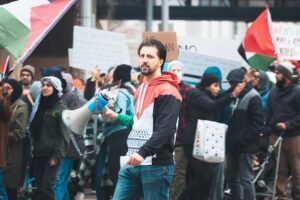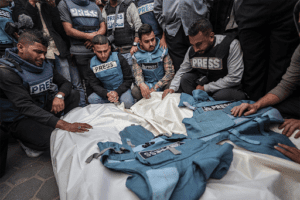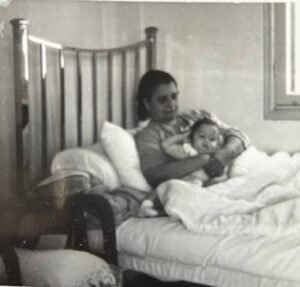In the wake of widespread coverage of Israeli atrocities in Gaza, three pro-Israel American moguls convened to raise funds for a campaign aimed at mitigating the anticipated backlash against the Jewish State. No wonder the three men have right-wing leanings, as the one who came up with the idea is the real estate and financial tycoon Barry Sternlicht, a well-known right-wing donor to the GOP. Sternlicht, reportedly, sought the collaboration of David Zaslav, the CEO of Warner Bros. Discovery who was associated with CNN’s drift to the right since 2022. Ari Emmanuel, The WWE owner and Endeavor CEO, agreed to coordinate the campaign. Notably, Emmanuel is the son of a former member of Irgun, the terrorist Zionist paramilitary organization implicated in the ethnic cleansing of the Arabs in Palestine. The campaign’s objective according to Sternlicht is to “define Hamas to the American people as a terrorist group,” which “is not just the enemy of Israel but of the United States.”
By focusing on Hamas, the American pro-Israel moguls aim to play the “magic but” trick in reshaping facts about the conflict in Palestine. After all the debates on ethnic cleansing, occupation, apartheid, war crimes and the rising Zionist fascism in Israel, the pro-Israel propaganda needs nothing more than putting one magic “but” followed by another magic word “terrorism”, “But Hamas is a terrorist group, so what we can do otherwise crushing it at any price?”. The exception here looks like Moses’ Staff, which, once cast down, engulfs all opposition like a serpent swallowing all snakes.
After 9/11, the word terrorism, one of the oldest words in the modern political dictionary dating back to the French Revolution, has been reduced to another magic word that eliminates the historicity of the object and rationality of the concept. Terrorism was made a charge that ends any political debate on the roots of violence and injustice, demonizing one party to beatify the other.
We try here to go beyond magic. This does not mean to justify Hamas or its acts or advocate its cause but means to contextualize Hamas and the whole conflict. In doing so, we aim to show how the Israeli-Palestinian conflict is not isolated from other struggles we face whether in the third world or even in the developed societies. Indeed, I think that the Israeli-Palestinian conflict lies at the heart of all struggles for justice all over the world, but for now, we need at least to know more about its ongoing happenings before conceiving how it intersects with our everyday struggles.
Yes, I am saying: National Liberation!
In 1944, the Zionist paramilitary organizations in mandatory Palestine rose against British colonization, and four years later, Israel fought against several Arab armies in what the Israelis call the Independence War. The years of conflict with the British and then war against the Arab countries allowed Israel to claim itself a fruit of a national liberation movement of the Jewish people in Palestine. But the historical facts tell us that the Zionist project and Israel building was anything but a national liberation movement.
At the beginning of British colonialism, there were little more than 75,000 out of the 750,000 population; the absolute majority of them were the indigenous Arabs. The British colonialism itself did not hide its aim of helping the Jewish people in Palestine have a state on the historical Palestine lands. Even the Zionist movement deemed itself a settler colonialist movement that aimed at confiscating the lands and properties of the underdeveloped indigenous that did not deserve their resources.
The dispute between the British and the Zionists did not erupt until the boom in Jewish settlement in Palestine with the rise of Nazism. With the Arabs revolting, the British occupation suppressed them killing some 5000 Palestinians, but issued the White Paper in 1939 that put restrictions on the Jewish immigration to Palestine. The Zionists saw the White Paper as a British abandonment of their joint colonialist project, but the eruption of WWII put off the Zionist insurgency against the British retreatment.
After the end of the war and the British mandate for Palestine, The UN under the influence of the Western powers decided the partition of Palestine. The small country was indivisible, and no one demanded the exit of the Jewish people even if they were settler colonialists, but the Arabs wanted a united country keeping Jews beside the indigenous Arabs. The Zionist exclusionary organizations, however, refused to live side by side with Arabs, and the Western powers wanted a Jewish state to solve the Jewish question in Europe, even on the account of the indigenous people. In 1948, the Israelis did not fight to liberate themselves from any occupation but fought to build an exclusionary Jewish state cleansing Arabs from their lands and rejecting to live in a united secular country.
The depiction of the Zionist settler colonialism in Palestine as a national liberation movement kills two birds with one stone. It covered the settler colonialist nature of the Jewish state in Palestine, then it deprived the Palestinian struggle to return to their lands that the Zionists took over from the right to struggle for national liberation.
When Hamas developed in Gaza after the Israeli occupation of the enclave in 1967, it grew from the fertile ground of refugee camps in the enclave. Ahmed Yassin, the founder and godfather of Hamas, was himself a refugee who was expelled at the age of 12 years from his village near Ashkelon by the Zionist paramilitaries in 1948. The man whom Israel holds responsible for the October 7 attack, Yahya Sinwar, grew up in Khan Younis refugee camp as his family was expelled from Ashkelon among 700,000 Palestinians cleansed by the Zionist paramilitaries. It is the same story of most Hamas leaders and militants.
No one remembered after the October 7 attack that Hamas gunmen did not break into the lands of the others but into the lands where their fathers and grandfathers were killed or expelled from in 1948, and every one of those young gunmen grew up in a refugee camp suffering from poverty and alienation because of the Zionist ethnic cleansing. The only one who never forgot this fact was Moshe Dayan, one of Israel’s founding fathers. One day after the killing of a settler near Gaza, Dayan reminded his colleague settlers with the fact, “Let us not cast the blame on the murderers today. Why should we declare their burning hatred for us? For eight years they have been sitting in the refugee camps in Gaza, and before their eyes, we have been transforming the lands and the villages, where they and their fathers dwelt, into our estate.”
Such rude frankness can explain more about Hamas than anything else. The Palestinian paramilitary organization cannot be understood today outside this long history, in which it represents only a link in the very long chain of the Palestinian struggle for human dignity and return to land.
Hamas and Islamic extremism
Hamas’ origin goes back to the Muslim Brotherhood, which is a religious political group founded in Egypt in 1928. The teachings of the founder focused on building the Islamic state with a pan-Islamist ambition, but over the years, the tenets of the group underwent moderation accepting democracy, equal citizenship rights, and rejecting religious discrimination as values congruent with Islam.
The Muslim Brotherhood branch in Palestine was inaugurated in 1945, but the group split, after the 1948 war, between the West Bank, where the members joined the Jordanian branch as Jordon assumed the administration of the region, and Gaza, where the members established their own organization. Both organizations remained dormant until 1979, when the Gazan organization under the guidance of Ahmed Yassin started to engage in public work and national struggle. In parallel, the Palestinian Muslim Brothers in Jordan and other Arab countries sought to find a united Palestinian branch of the Muslim Brotherhood to start a struggle against the occupation. The endeavour succeeded in 1985 by establishing the Palestinian Office of the Muslim Brotherhood under the leadership of the Palestinian Saudi businessman Khairy Al-Agha.
In 1991, the first general assembly of the organization gathered and elected a political bureau to lead the organization from outside Palestine, while the West Bank and Gaza had administrative offices. The name of Hamas, however, was released earlier by the Gazan group after the eruption of the 1987 Intifada (uprising) in Gaza and the West Bank, but the spread and success of the name encouraged the mother organization to adopt it.
Hamas, along with other Muslim Brotherhood groups, declares they believe in the congruence between Islam and democracy and rejects religious and ethnic discrimination. And despite the organization’s paramilitary activity, it denounced Islamic extremist groups like Al-Qaeda and ISIS for their fanatic dogmas and terrorist attacks on civilians. The Muslim Brotherhood, accordingly, was the target of Al-Qaeda’s second man Ayman Al-Zawahiri who authored a book, The Bitter Yield, attacking the Muslim Brotherhood for what he sees as abandoning Islam by accepting democracy and citizenship. Later, ISIS deemed Hamas infidel, and in 2018, ISIS released a footage titled, Abraham’s Credo, alarming people in Sinai that capital punishment would be the destiny of anyone who would attempt to help Hamas in Gaza.
Is Hamas antisemitic?
Some of Hamas’ founders were old Muslim Brotherhood members who had quite limited political orientation and were not able to articulate their struggle against the occupation outside the religious terms they used to use. One of them was Abdel Fattah Dokhan, a senior official of the Gazan organization, who took the initiative to write a charter for Hamas and release it during the Intifada protests. The charter repeated the jargon of battling between Muslims and Jews and excerpted a text from the prophet Mohamed’s Hadith prophesying that Muslims will war with the Jews before the doomsday and the trees will talk to tell Muslims about the places of hidden Jews to kill them. The anti-Jewish religious sentiment was so obvious in the text but the later clarifications by the group’s leaders illuminated the political nature of conflict with Israel excluding antisemitic connotations.
Ahmed Yassin, recurrently, stated that he, being a man of faith in God, likes the Jews who are men of faith in God, but he once told reporters, “I have lands in Ashkelon and others have lands in other places, we demand our rights nothing more.” The veteran political leader of Hamas, Khaled Meshaal, described the charter as “a piece of history and no longer relevant.” In 2017, Hamas released a new document on its principles stipulating in article 16, “Hamas confirms that the struggle with the Zionist projects is not a struggle with the Jews due to their religion, and Hamas does not fight against Jews for being Jews but fights against the aggressor occupant Zionists.” In the following article, the charter stressed the rejection of discrimination on a national, religious, or sectarian basis and the organization sees antisemitism as a European historical phenomenon alien to the Islamic history and heritage.
The slogan of liberating Palestine from the river (the Jordan River that borders Palestine from the east) to the Sea (the Mediterranean that borders the country from the west) does not express a desire to expel Jews, but rather to get the Palestinians back to their lands all over Palestine ending the apartheid that Israel used against the Arabs since 1948.
The Israeli hardliners used to dismiss all Hamas statements against antisemitic charges as merely cosmetic. They use excerpts from the Palestinians’ talks using the word “Jews” as a description of their enemy. In Palestine, the Arabs used to call the settlers who expelled them and took over their lands “the Jews”, but they, overall, are aware that they are not fighting against the Jews for being Jews, but against the settlers for taking over their land and stripping the Palestinians off their rights.
What is at stake here is not the credibility of Hamas but to understand the complexity of the conflict far from the propaganda. The Palestinian-Israeli conflict is deeply tied to the Jewish question in Europe, but it cannot be reduced to the European concerns over the history of antisemitism. So, when the Palestinians and others all over the world combat Israeli fascism, apartheid and occupation, antisemitism is by no means the only game in the town.
Iranian proxy?
On January 1, 1965, the Palestinian National Liberation Movement known as Fatah declared the launch of an armed struggle against Israeli settler colonialism. By then, Iran was a cornerstone in the US clout over the Middle East, and the Iranian Shah was among the few allies who could compete with Israel on American solicitude. After the ouster of the Shah in 1979, the Palestinians were of course among the first well-wishers of the new Iranian Islamic regime that declared absolute support of the Palestinian cause. Likewise, Hamas had no option but to consolidate ties with the Iranians, the only supporters who evaded the American red lines the Arabs used to sanctify.
Hamas, however, did not hesitate in 2012 to sacrifice ties with Iran and its allies after they engaged in crimes against the Syrian people. The tensions between Hamas and Iran continued until 2017 when significant changes occurred in Hamas leadership. Khaled Mashal, who was held responsible for the divergence, left the leadership for Ismail Haniyeh, who shows no specific leanings towards or against Iran. Besides Haniyeh, two leaders ascended, Yahya Sinwar, the leader of the Gaza department, and Saleh Arouri, who led the West Bank department from abroad. Both Sinwar and Arouri showed enthusiasm to strengthen ties with Iran in order to receive the necessary Iranian shore for the organization’s paramilitary wing, Izz ad-Din al-Qassam Brigades. Hamas was keen, however, on stressing its neutral position in the regional conflict between Saudi Arabia and Iran, and recurrently confirmed its desire to restore strong ties with Saudi Arabia too.
The only base of the Hamas-Iranian alliance was the common struggle with Israel, even if they had different reasons for the struggle. Some leaders of Hamas like Mashal, who is still leading the Hamas organization outside Palestine, still have suspects and concerns over the Iranian support, but they have nothing to do in the absence of a big Arab supporter of the Palestinians, as both Egypt and Saudi Arabia are keen on convergence with Israel and the United States.
After all, much more is still required to grasp a full understanding of Hamas and other Palestinian militant organizations. In fact, Hamas is more of an umbrella-like organization that gathers many components with variable leanings, but all of them share the faith in a free Palestine based on democracy and equality. What this essay aims at is to end the magic exception that depicts the elimination of Hamas as a common cause that can justify or omit every Israeli crime. Far from that, this essay says that we should not demonize Hamas and reduce it to the stereotypes of counterterrorism rhetoric. Hamas is a quite complicated organization engaged in a complex conflict and has many valid causes, so we have to hang over its words.









